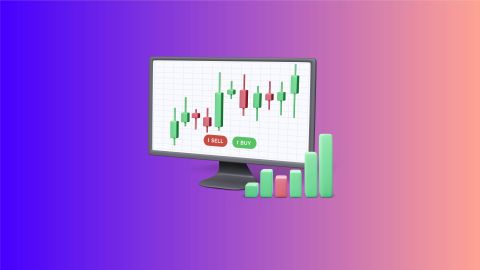Examples of simple trading algorithms
Initiate a short position of 20 lots in GBP/USD if the rate exceeds 1.2012. For every 5-pip increase beyond this level, reduce the short by 2 lots. Conversely, for every 5-pip decline, expand the short position by 1 lot.
Buy 100,000 XYZ shares if the price dips below Rs. 200. For each 0.1% rise above Rs. 200, purchase an additional 1,000 shares. For every 0.1% drop below Rs. 200, sell 1,000 shares.
How algorithmic trading works?
Algorithmic trading involves creating a set of instructions or code that enables a computer to automatically buy or sell securities like stocks, futures, or options. These trades are executed based on predefined parameters such as price, volume, timing, or complex mathematical models.
1. Trade criteria
The trading strategy employed involves the following criteria:
- Buy signal: Initiate a long position (purchase 50 shares) when the 50-day moving average of the stock price surpasses the 200-day moving average.
- Sell signal: Liquidate the existing position (sell all shares) when the 50-day moving average falls below the 200-day moving average.
2. System implementation
This trading strategy is executed through an automated system. The system continuously monitors the stock price and calculates the 50-day and 200-day moving averages in real-time. Upon detection of the specified buy or sell signal, the system automatically places the corresponding order.
3. Benefits
This automated approach eliminates the need for manual price monitoring, chart analysis, and order placement. By identifying and capitalising on trading opportunities algorithmically, the system enhances efficiency and reduces the potential for human error.
Algorithmic trading strategies
If you are a seasoned trader, you may already be familiar with various manual trading strategies. Many of these techniques can also be used in algorithmic trading. Let’s take a closer look at how to do algo trading using some popular trading strategies.
1. Trend following
This strategy focuses on identifying and capitalising on existing market trends using historical data to predict future price movement. You would assume that the current trend will persist and position yourself in the same direction as the trend to benefit from its continuation.
2. Arbitrage
Arbitrage exploits price differences for the same asset across markets. It involves buying and selling simultaneously to benefit from discrepancies. This often demands sophisticated algorithms for rapid execution to secure profits before the price gap closes.
3. Mean reversion
Mean reversion strategies assume asset prices tend to return to their long-term average. You would look for substantial deviations from historical norms, trading on the expectation that the price will revert to its mean over time.
4. Index fund rebalancing
This involves anticipating changes index funds make to align with their benchmarks. Traders aim to act ahead of these adjustments, forecasting how large-scale fund activity might impact stock prices during the rebalancing period.
5. Market timing
Market timing strategies aim to pinpoint ideal moments to enter or exit trades by analysing indicators and market signals. The goal is to maximise returns by accurately predicting short-term price movements, requiring sharp analysis and swift execution.
How to get started with algorithmic trading?
Getting started with algorithmic trading involves more than just writing code. You need a clear understanding of markets, rules, tools, and risk. A structured approach helps you build systems that are disciplined, repeatable, and aligned with your trading objectives. Below are eight practical steps to help you systematically begin algorithmic trading.
Understand the basics of financial markets
Start by learning how equity, derivatives, and currency markets function. You should understand order types, trading sessions, liquidity, volatility, and regulatory requirements before automating any strategy.
Learn programming fundamentals
Choose a programming language commonly used in trading, such as Python or Java. Focus on logic building, data handling, and basic algorithm design rather than complex coding at the start.
Define your trading strategy
Clearly outline the rules your algorithm will follow. This includes entry conditions, exit rules, position sizing, timeframes, and risk controls. The logic must be precise and free from ambiguity.
Access reliable market data
Obtain quality historical and real-time market data. Accurate data is essential for testing strategies and ensuring your algorithm behaves as expected under different market conditions.
Back-test the strategy
Test your algorithm on historical data to evaluate performance, drawdowns, and consistency. Back-testing helps you understand how the strategy may behave across varying market cycles.
Choose a trading platform or broker
Select a broker or platform that supports algorithmic trading and offers stable APIs, execution reliability, and compliance with exchange regulations.
Start with paper trading
Run your algorithm in a simulated environment using virtual funds. This allows you to observe live behaviour without financial exposure and identify execution or logic issues.
Monitor and refine continuously
Even after deployment, regularly review performance, execution quality, and risk metrics. Market conditions change, and algorithms require periodic evaluation and adjustment.
Algorithmic trading in India and SEBI regulations
Algorithmic trading in India has grown steadily with increased adoption by institutional investors, proprietary traders, and retail participants using automated strategies. It involves using computer programs to place trades based on predefined rules such as price, volume, timing, or technical indicators. The rise of advanced trading platforms and faster market infrastructure has made algorithmic trading more accessible across Indian stock exchanges.
SEBI regulates algorithmic trading to ensure fair, transparent, and orderly markets. Exchanges like NSE and BSE require algorithms to undergo approval and testing before deployment. Risk controls such as price bands, order limits, and kill switches are mandatory to prevent market disruptions caused by faulty algorithms.
SEBI also mandates broker-level oversight, audit trails, and periodic system checks. Retail investors using algorithmic strategies through brokers must comply with exchange guidelines. These regulations aim to balance innovation with market integrity, reducing systemic risks while allowing technology-driven trading to evolve responsibly.
Benefits of algorithmic trading
Now that you know what algo trading is and how to do algo trading using common trading strategies, let’s take a closer look at the benefits of algo trading. These benefits include the following:
Traders receive optimal pricing on trades.
Trade orders are placed instantly and accurately.
Orders are executed quickly to minimise adverse price movement.
Emotional and psychological trading errors are significantly reduced.
Transaction costs are lower.
Multiple market conditions can be evaluated simultaneously.
Manual entry errors are greatly minimised.
Strategies can be tested using historical and real-time data.
Ideal for time-sensitive trading operations.
Disadvantages of algorithmic trading
Drawbacks of algorithmic trading are as follows:
Latency risks
Algorithmic trading depends on ultra-fast execution. Even slight delays or higher latency can result in missed opportunities or unfavourable prices, leading to potential losses in fast-moving markets.
Exposure to black swan events
Algorithms rely on historical data and models. Unexpected market shocks or rare events can break these assumptions, causing strategies to perform poorly or incur significant losses.
Heavy technological dependence
Algo trading relies on stable software, servers, and internet connectivity. System glitches, hardware failures, or network disruptions can interrupt trades and create financial risk.
Market impact concerns
Large algorithmic orders can influence prices and liquidity. In some cases, this has contributed to heightened volatility and events such as flash crashes.
Regulatory compliance challenges
Algorithmic trading operates under strict regulatory frameworks. Meeting compliance, audit, and reporting requirements can be complex and time-intensive.
High capital and setup costs
Developing, testing, and maintaining algorithms involves costs for technology, data feeds, and infrastructure, making entry expensive for some participants.
Limited flexibility and customisation
Algorithms follow predefined rules, which may restrict quick adjustments to changing market conditions or unique trading preferences.
Absence of human judgment
Algorithms ignore qualitative factors such as sentiment, news interpretation, or intuition, which can sometimes play a critical role in market movements.
Algo-trading time scales
Algorithmic trading operates across different time scales, depending on strategy design, risk appetite, and market objectives. Each time scale determines how frequently trades are executed and how long positions are held.
High-frequency and ultra-short-term strategies operate within milliseconds or seconds. These algorithms focus on small price movements, liquidity gaps, or order book imbalances, relying heavily on speed, low latency, and infrastructure efficiency.
Intraday algorithmic trading strategies function within a single trading session. Positions are opened and closed on the same day, using indicators, price patterns, or volume signals to capture short-term trends without overnight exposure.
Longer-term algorithmic strategies span days, weeks, or even months. These systems rely on broader market trends, statistical models, or portfolio rebalancing rules, prioritising consistency and risk control over execution speed.
Difference between algorithmic trading and manual trading
Algorithmic trading and manual trading differ mainly in execution style, decision-making, and reliance on technology. Understanding these differences helps you choose an approach that aligns with your trading goals, time availability, and risk tolerance. Both methods operate in the same markets but function very differently in practice.
1. Decision-making process
Algorithmic trading relies on predefined rules, mathematical models, and historical data to make decisions automatically. Manual trading depends on human judgment, experience, and real-time interpretation of market conditions.
2. Speed and efficiency
Algorithms execute trades at very high speeds with minimal delay. Manual trading is slower, as it involves analysis, decision-making, and order placement by a trader.
3. Emotional influence
Algorithmic trading removes emotions such as fear and greed from execution. Manual trading is more prone to emotional bias, especially during volatile market conditions.
4. Consistency
Algorithms follow the same rules consistently across trades. Manual trading may vary depending on market sentiment, fatigue, or changing perceptions.
5. Monitoring and involvement
Algorithmic trading requires setup and monitoring but less constant attention. Manual trading demands active involvement and continuous market tracking.
6. Cost and accessibility
Algorithmic trading may involve higher setup and technology costs. Manual trading has lower entry barriers but demands more time and effort.
Conclusion
You need the right platforms and tools to fully leverage the many algo trading benefits. Today, many leading stockbrokers offer algo trading apps to help retail traders automate their trading strategies. However, before you use these tools, you must become well-acquainted with how to do algo trading in different market conditions.
Related articles
How To Do Bank Nifty Intraday Options Trading
What Is The Difference Between Demat And Trading Account
How To Use Pivot Point In Intraday Trading
Difference Between Online And Offline Trading
What Is Commodity Trading





